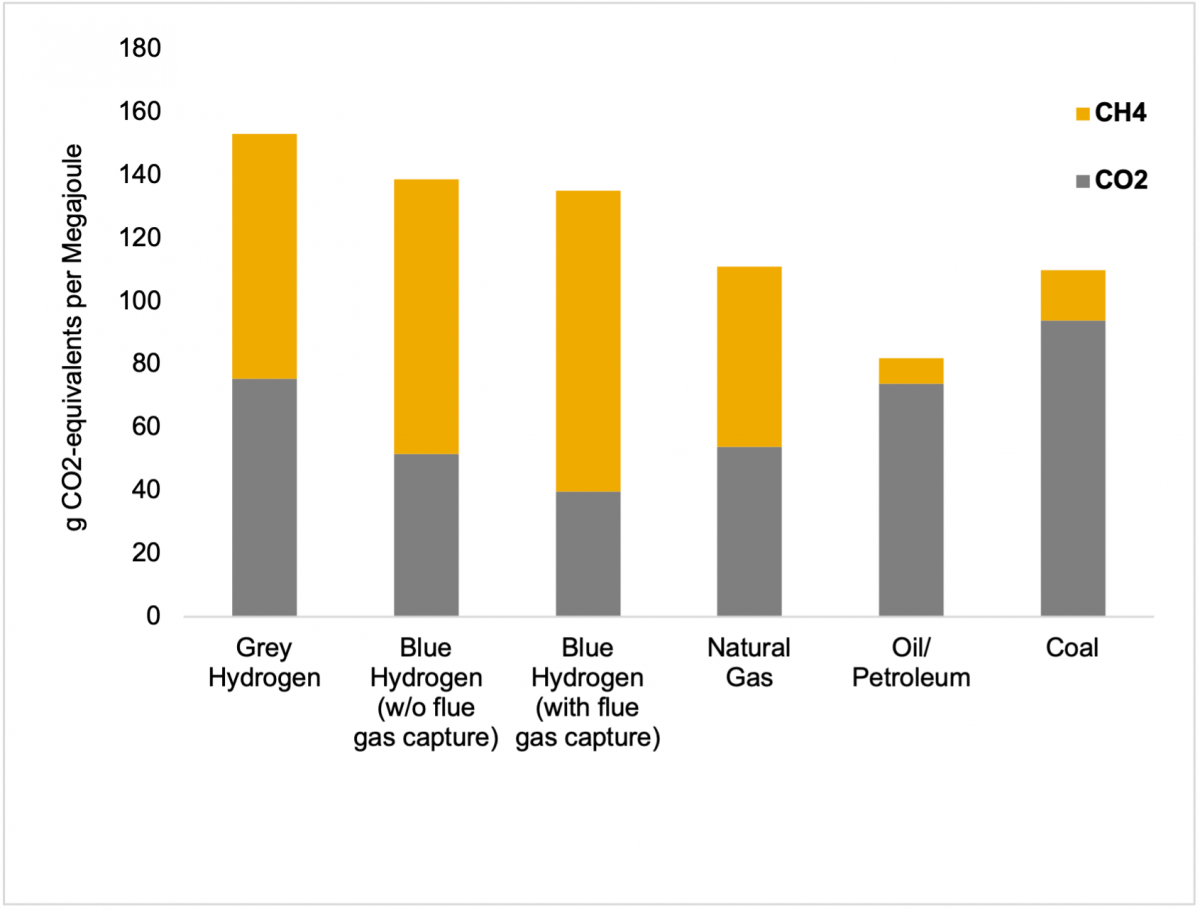Is Blue Hydrogen a Worthy Contender for Net Zero Transition?

To limit global warming to 1.5 degrees Celsius and lower carbon emissions, many pathways are being investigated, one of which is the use of hydrogen as an alternative energy vector. Although hydrogen is the most abundant element, it doesn’t exist independently. For hydrogen to emerge as a clean fuel contender, it is critical to evaluate how hydrogen is produced (to check emissions) and its use across sectors. Colour-coded (green, blue, grey, etc.) hydrogen is based on its production process.
Grey hydrogen is produced from natural gas whereas blue hydrogen, although produced from natural gas, goes a step further to capture, utilize, and store carbon dioxide (CO2) using Carbon Capture Usage and Storage (CCUS) methods. Green hydrogen, on the other hand, is produced from the electrolysis of water using renewable power.
Although it has been 50 years since the development of CCUS with multiple pilot projects, there hasn’t been much progress in the installed number of projects. Currently, there are 65 large-scale CCUS facilities across the globe, of which just 26 are in operation, two have suspended operations, three are under construction, and 34 are in various stages of development. Of these, as of 2021, there are only two blue hydrogen facilities that use natural gas to produce hydrogen at a commercial scale. Majority of remaining facilities are used for natural gas processing.
Countries around the world have adopted different pathways to support the use of hydrogen irrespective of colour. A glance at hydrogen policies around the world reveals that the UK aims for 5 gigawatts (GW) of low carbon hydrogen capacity by 2030, and has opted for a twin-track approach supporting both blue and green hydrogen. Countries like the US, Canada, China, and Japan have adopted hydrogen production technologies that can pave the way to blue hydrogen. In India private conglomerates are targeting blue hydrogen in the interim period till the price of green hydrogen has cost parity with its grey counterpart.
Hydrogen production the traditional way: Steam Methane Reforming (SMR)
The two conventional ways of producing hydrogen are SMR and auto-thermal reforming with a gas heater reformer, both of which require additional infrastructure to capture the CO2 produced during the process. The dominant process for industrial-scale hydrogen production is the highly energy-intensive SMR one.
To classify hydrogen produced as blue, the CO2 generated through the SMR process must be captured, sequestered, or utilized in other applications. According to literature, an SMR process with CCUS consumes about 60% more electricity than a traditional SMR process without CCUS. This captured CO2 can be stored underground, but almost 88% of this CO2 is re-used for enhanced oil recovery (EOR).
Blue Hydrogen: Envisioning Environmental Impacts
Greenhouse Gas (GHG) emissions from the production of blue hydrogen account for emissions from both CO2 and unburned fugitive methane. Methane can warm the earth 80 times faster than CO2 in its first 20 years of release into the atmosphere, accounting for approximately 25% of the net global warming in the last decade alone.
According to a study in August 2021, the CO2 equivalent emissions from blue hydrogen production are only 9-12% less than emissions from grey hydrogen. While CO2 emissions are lower, methane emissions are higher in blue hydrogen due to increased use of natural gas to power carbon capture. It is important to note that this study assumes a methane leakage rate of 3.5%. The small reduction in CO2 emissions is made up of larger emission from methane (Figure 1). Cost of storage and transportation is one of the major bottlenecks for this technology and the fact remains that carbon capture can never be 100 % efficient. Additionally, there is no experience on a commercial scale in storing CO2, from carbon capture, for a longer period. Lastly, there is great uncertainty over the climate impact of methane leakage. These findings suggest incorporating blue hydrogen in future energy mix should be approached with prudence.

A safer Hydrogen Policy
For policymakers here are a few suggestions that can be considered while adopting the use of blue hydrogen:
- Stricter regulations for blue hydrogen: If blue hydrogen is catered as an interim way of cutting down carbon emissions, it is important to have sound regulations in place like higher CO2 capture (preferably above 90%) with minimal methane leakage based on the entire life cycle approach.
- Adequate monitoring and verification facilities: There should be proper monitoring and verification mechanisms otherwise there is a risk of underperformance even with ambitious standards.
- Prioritize green hydrogen over blue: As blue hydrogen can never be carbon-free preference should be given to the production of green hydrogen based on the availability of renewable power.
The efficiency improvements in carbon capture technology and ambitious targets for RE to meet green hydrogen demand might lead to blue hydrogen becoming the interim low-carbon pathway to expedite the development of a hydrogen economy. However, the use of blue hydrogen should be approached with caution and only for timely decarbonization and for developing a market switch to green hydrogen expediently.
Views are personal.
